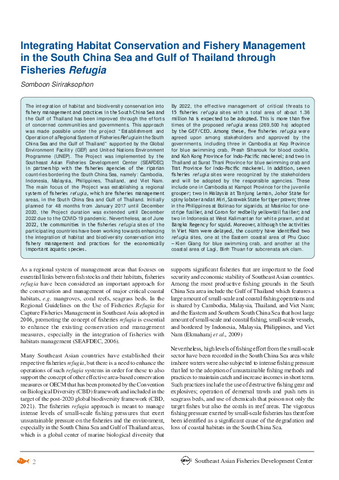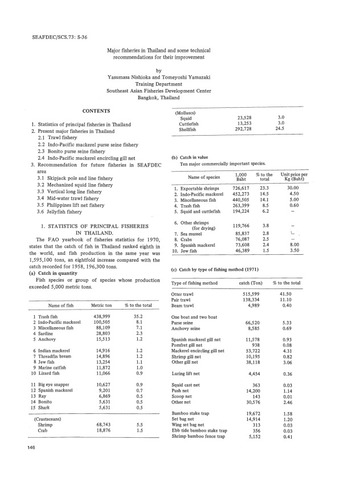| dc.description.abstract | The integration of habitat and biodiversity conservation into fishery management and practices in the South China Sea and the Gulf of Thailand has been improved through the efforts of concerned communities and governments. This approach was made possible under the project “Establishment and Operation of a Regional System of Fisheries Refugia in the South China Sea and the Gulf of Thailand” supported by the Global Environment Facility (GEF) and United Nations Environment Programme (UNEP). The Project was implemented by the Southeast Asian Fisheries Development Center (SEAFDEC) in partnership with the fisheries agencies of the riparian countries bordering the South China Sea, namely: Cambodia, Indonesia, Malaysia, Philippines, Thailand, and Viet Nam. The main focus of the Project was establishing a regional system of fisheries refugia, which are fisheries management areas, in the South China Sea and Gulf of Thailand. Initially planned for 48 months from January 2017 until December 2020, the Project duration was extended until December 2022 due to the COVID-19 pandemic. Nevertheless, as of June 2022, the communities in the fisheries refugia sites of the participating countries have been working towards enhancing the integration of habitat and biodiversity conservation into fishery management and practices for the economically important aquatic species.
By 2022, the effective management of critical threats to 15 fisheries refugia sites with a total area of about 1.36 million ha is expected to be adopted. This is more than five times of the proposed refugia areas (269,500 ha) adopted by the GEF/CEO. Among these, five fisheries refugia were agreed upon among stakeholders and approved by the governments, including three in Cambodia at Kep Province for blue swimming crab, Preah Sihanouk for blood cockle, and Koh Kong Province for Indo-Pacific mackerel; and two in Thailand at Surat Thani Province for blue swimming crab and Trat Province for Indo-Pacific mackerel. In addition, seven fisheries refugia sites were recognized by the stakeholders and will be adopted by the responsible agencies. These include one in Cambodia at Kampot Province for the juvenile grouper; two in Malaysia at Tanjung Leman, Johor State for spiny lobster and at Miri, Sarawak State for tiger prawn; three in the Philippines at Bolinao for siganids, at Masinloc for onestripe fusilier, and Coron for redbelly yellowtail fusilier; and two in Indonesia at West Kalimantan for white prawn, and at Bangka Regency for squid. Moreover, although the activities in Viet Nam were delayed, the country have identified two refugia sites, one at the Eastern coastal area of Phu Quoc
– Kien Giang for blue swimming crab, and another at the coastal area of Lagi, Binh Thuan for subcrenata ark clam. | en |




